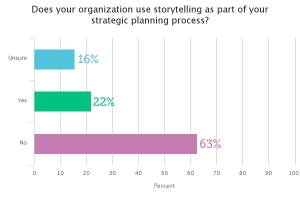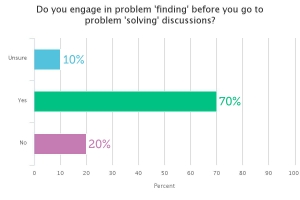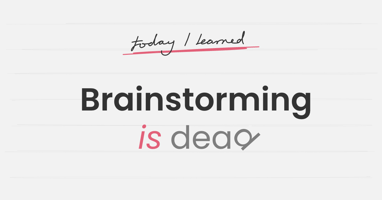The second webinar in our #RoadmappingSeries, The Power of Problem Finding & Storytelling, was well-attended and sparked a captivating question and answer session with guest speakers Dr. Irene Petrick and Russ Martinelli from Trendscape Innovation Group.
Irene and Russ spoke to the tried and true method of discussing future problems instead of immediately jumping to solving these problems.
First, they emphasized the importance of examining the end-user. By outlining descriptors, giving the end-user personas and thinking about the protagonist's goals, they can empower team members in the roadmapping lifecycle to understand the context around why the end-user makes purchasing decisions.
Russ and Irene also tackled how important it is to identify different kinds of problems that may come down the pipeline in the future. As Russ explained, “It's easy to find problems that everybody sees, but it's not easy to monetize and have competitive advantage when you are solving a problem that everybody sees. The problems that we are trying to get teams to find are the non-obvious ones.”
Webinar Polls
Two polls were presented during this webinar session. The first poll posed the question, “Does your organization use storytelling as part of your strategic planning process?”
Our audience responded:
 With 63% not engaging in storytelling, it's important to add this extremely powerful technique in strategic planning to your roadmapping process.
With 63% not engaging in storytelling, it's important to add this extremely powerful technique in strategic planning to your roadmapping process.
The second poll asked, “Do you engage in problem ‘finding' before you go to problem ‘solving' discussions?
The results showed: This survey surprised Russ a bit, with a whopping 70% of respondents using problem finding before jumping to problem solving. It's great that so many attendees utilize this best-practice method!
This survey surprised Russ a bit, with a whopping 70% of respondents using problem finding before jumping to problem solving. It's great that so many attendees utilize this best-practice method!
Questions from Audience Members
After the presentation a discussion broke out between the audience and the guest speakers. Here is the transcript of part of the Q&A session.
Q: Don't you need some level of innovation blindness in order to create solutions that fit your core competencies?
Irene: Where innovation blindness becomes a problem is when it turns into arrogance. It's one thing to say we don't want to envision a solution that our company would never do. I understand that. Too often we've seen — and particularly with companies that are a leader in a segment —that innovation blindness is often coupled with arrogance. That's where we see the problem.
Q: How do you make sure that storytelling doesn't become too “left field” from my core competencies?
Russ: In the first webinar, we talked about where we start with this whole process — creating that call to action. It's understanding the strategic threats and opportunities that are right in front of you.
In storytelling, the call to action provides the guardrails, if you would, or constraints about where you want to focus your story.
Q: Is mind mapping a technique that you can use in your proposed Act 2?
Irene: That's a great question. We have not specifically used mind mapping. But, it can be used effectively depending on the situation and depending on the familiarity of the team with that technique.
With storytelling, we try and balance the number of tools we ask teams to use. Mind mapping can be effectively used particularly if you are trying to identify really sequential kinds of differences. You can begin to group ideas. You can begin to group end-user problems.
Russ: I agree. That's a great question. I was visualizing a mind map as you were speaking in where it could absolutely be used as you are evaluating the various problems across the stories and the scenarios to create those common solutions that are needed. Good question.
Q: In this session, you've introduced and talked about using conflicting trends to create a story. Can you give an example of what you mean by conflicting trends?
Irene: We were looking at the rise of potential for high-performance computing. Two conflicting trends that came up: 1) the consumer wants to have, produce and upload content (which makes it increasingly complex from a file size perspective), and 2) the bandwidth is limited by increasing video traffic. Speeds and feeds would be much reduced to upload and download some of these. Those are 2 trends that would be in conflict.
Stay tuned for more blog posts and content generated from our # RoadmappingSeries !





